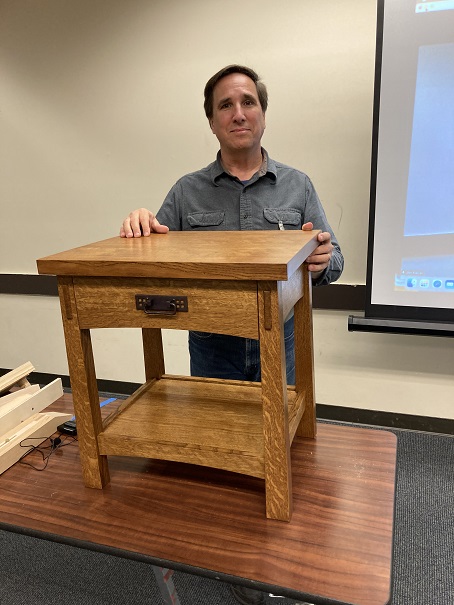Newsletter October 2023
Top
President's Message
Rebuilding of the Notre-Dame
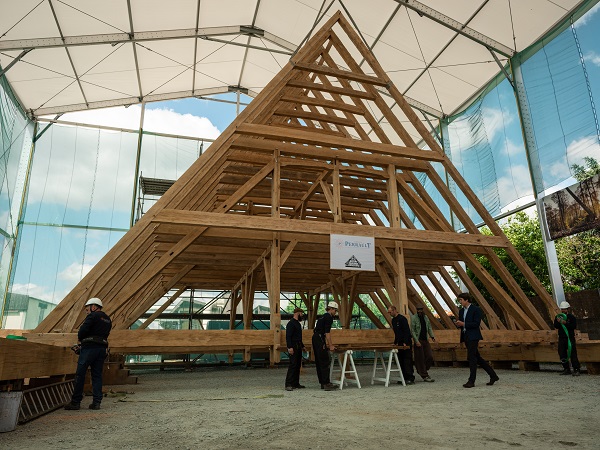
The rebuilding of the spire and transom of the Notre-Dame must be the biggest carpentry project in the world at the moment.
It must be several 100 years since the manual hewing and assembling of a wooden structure on this magnitude was last done
From the acquiring of 1260 old growth Oaks in France to the assembling of teams of skilled carpenters from around the world, it is a momentous task.
If your random viewing has not yet drifted into this area it is worth a looking at a few of the videos.
These are links to just a few of the many available on Youtube
youtube.com/watch?v=YlZQWxCu4_c&t=298s
youtube.com/watch?v=orEaNz8EVDI
youtube.com/watch?v=S-OydamPKkE
youtube.com/watch?v=7QDMBE_O44c&t=255s
Enjoy your woodworkug
Frank
BAWA in-person / Zoom Meeting October 15th. 2023
Program Announcements – Paul Krenitsky
Paul said that the picnic was a success and the planing competition was fun.
November speaker: Roman Chernikov discussing chip carving.
December meeting will be our annual Pot Luck
Paul mentioned that he does not have a speaker lined up for the January meeting and would like BAWA members to come up with suggestions.
Paul announced that beginning in 2024, no more combined in-person and Zoom meetings. In-person only.
He also asked for a volunteer to bring refreshments to the meetings.
Bruce announced that he will be exhibiting his woodwork at the Open Studios at Fort Mason Center on November 10, 11, and 12.
He also restated the fact that he has a 20" Hegner scroll saw for sale. He is asking $500.
Top
Featured Speaker
BAWA Member Neal White
Kimiko work
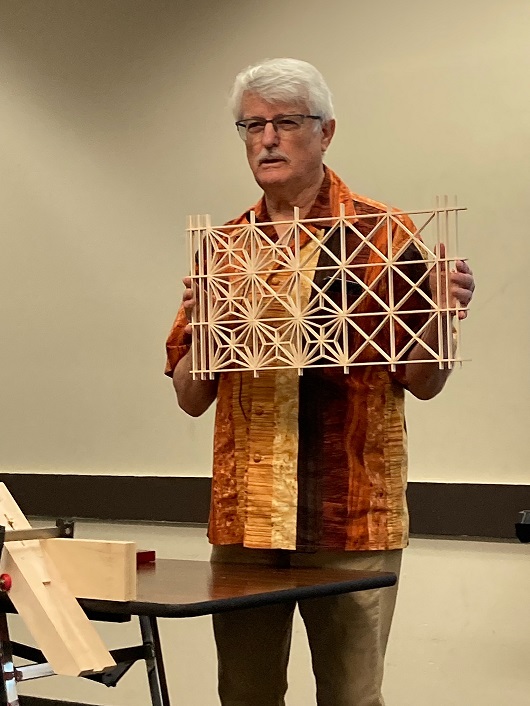
Neal mentioned that he shares a 9000 square foot shop in Hilton Head, South Carolina.
It is part of a guild that has 900 members, 250 of them are active, and 150 are very active.
He recommended the book by Matt Kenney: The Art of Kumiko
Enjoy your woodworkug
Frank
BAWA in-person / Zoom Meeting October 15th. 2023
Program Announcements – Paul Krenitsky
Paul said that the picnic was a success and the planing competition was fun.
November speaker: Roman Chernikov discussing chip carving.
December meeting will be our annual Pot Luck
Paul mentioned that he does not have a speaker lined up for the January meeting and would like BAWA members to come up with suggestions.
Paul announced that beginning in 2024, no more combined in-person and Zoom meetings. In-person only.
He also asked for a volunteer to bring refreshments to the meetings.
Bruce announced that he will be exhibiting his woodwork at the Open Studios at Fort Mason Center on November 10, 11, and 12.
He also restated the fact that he has a 20" Hegner scroll saw for sale. He is asking $500.
Top
Featured Speaker
BAWA Member Neal White
Kimiko work

Neal mentioned that he shares a 9000 square foot shop in Hilton Head, South Carolina.
It is part of a guild that has 900 members, 250 of them are active, and 150 are very active.
He recommended the book by Matt Kenney: The Art of Kumiko
Paul said that the picnic was a success and the planing competition was fun.
November speaker: Roman Chernikov discussing chip carving.
December meeting will be our annual Pot Luck
Paul mentioned that he does not have a speaker lined up for the January meeting and would like BAWA members to come up with suggestions.
Paul announced that beginning in 2024, no more combined in-person and Zoom meetings. In-person only.
He also asked for a volunteer to bring refreshments to the meetings.
Bruce announced that he will be exhibiting his woodwork at the Open Studios at Fort Mason Center on November 10, 11, and 12.
He also restated the fact that he has a 20" Hegner scroll saw for sale. He is asking $500.
Top
Featured Speaker
BAWA Member Neal White
Kimiko work

Neal mentioned that he shares a 9000 square foot shop in Hilton Head, South Carolina.
It is part of a guild that has 900 members, 250 of them are active, and 150 are very active.
He recommended the book by Matt Kenney: The Art of Kumiko
November speaker: Roman Chernikov discussing chip carving.
December meeting will be our annual Pot Luck
Paul mentioned that he does not have a speaker lined up for the January meeting and would like BAWA members to come up with suggestions.
Paul announced that beginning in 2024, no more combined in-person and Zoom meetings. In-person only.
He also asked for a volunteer to bring refreshments to the meetings.
Bruce announced that he will be exhibiting his woodwork at the Open Studios at Fort Mason Center on November 10, 11, and 12.
He also restated the fact that he has a 20" Hegner scroll saw for sale. He is asking $500.
Top
Featured Speaker
BAWA Member Neal White
Kimiko work

Neal mentioned that he shares a 9000 square foot shop in Hilton Head, South Carolina.
It is part of a guild that has 900 members, 250 of them are active, and 150 are very active.
He recommended the book by Matt Kenney: The Art of Kumiko
Paul mentioned that he does not have a speaker lined up for the January meeting and would like BAWA members to come up with suggestions.
Paul announced that beginning in 2024, no more combined in-person and Zoom meetings. In-person only.
He also asked for a volunteer to bring refreshments to the meetings.
Bruce announced that he will be exhibiting his woodwork at the Open Studios at Fort Mason Center on November 10, 11, and 12.
He also restated the fact that he has a 20" Hegner scroll saw for sale. He is asking $500.
Top
Featured Speaker
BAWA Member Neal White
Kimiko work

Neal mentioned that he shares a 9000 square foot shop in Hilton Head, South Carolina.
It is part of a guild that has 900 members, 250 of them are active, and 150 are very active.
He recommended the book by Matt Kenney: The Art of Kumiko
Paul announced that beginning in 2024, no more combined in-person and Zoom meetings. In-person only.
He also asked for a volunteer to bring refreshments to the meetings.
Bruce announced that he will be exhibiting his woodwork at the Open Studios at Fort Mason Center on November 10, 11, and 12.
He also restated the fact that he has a 20" Hegner scroll saw for sale. He is asking $500.
Top
Featured Speaker
BAWA Member Neal White
Kimiko work

Neal mentioned that he shares a 9000 square foot shop in Hilton Head, South Carolina.
It is part of a guild that has 900 members, 250 of them are active, and 150 are very active.
He recommended the book by Matt Kenney: The Art of Kumiko
He also asked for a volunteer to bring refreshments to the meetings.
Bruce announced that he will be exhibiting his woodwork at the Open Studios at Fort Mason Center on November 10, 11, and 12.
He also restated the fact that he has a 20" Hegner scroll saw for sale. He is asking $500.
Top
Featured Speaker
BAWA Member Neal White
Kimiko work

Neal mentioned that he shares a 9000 square foot shop in Hilton Head, South Carolina.
It is part of a guild that has 900 members, 250 of them are active, and 150 are very active.
He recommended the book by Matt Kenney: The Art of Kumiko
He also restated the fact that he has a 20" Hegner scroll saw for sale. He is asking $500.
Top
Featured Speaker
BAWA Member Neal White
Kimiko work

Neal mentioned that he shares a 9000 square foot shop in Hilton Head, South Carolina.
It is part of a guild that has 900 members, 250 of them are active, and 150 are very active.
He recommended the book by Matt Kenney: The Art of Kumiko
Top
Featured Speaker
BAWA Member Neal White
Kimiko work

Neal mentioned that he shares a 9000 square foot shop in Hilton Head, South Carolina.
It is part of a guild that has 900 members, 250 of them are active, and 150 are very active.
He recommended the book by Matt Kenney: The Art of Kumiko
BAWA Member Neal White
Kimiko work
It is part of a guild that has 900 members, 250 of them are active, and 150 are very active.
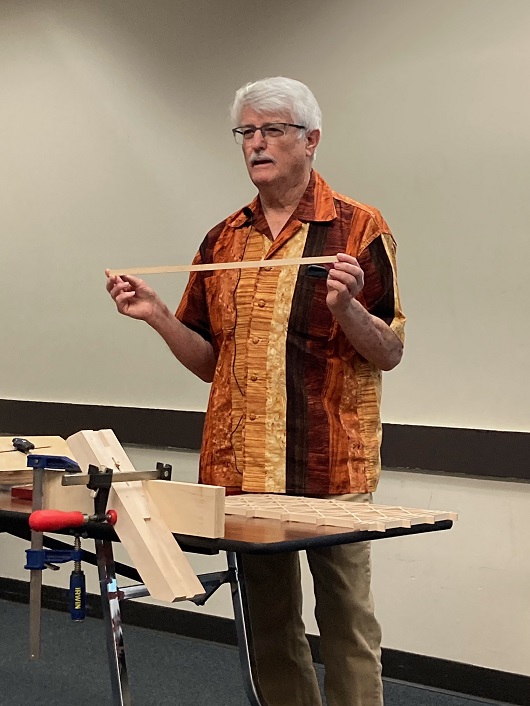
A strip of Basewood ready to cut
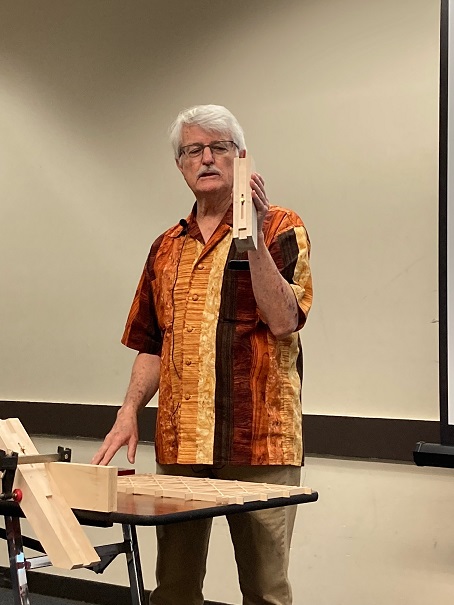
Block for cutting the strips
Neal uses northern Basswood for his Kumiko. Port Orford Cedar and Poplar can also be used.
He sourced the Basswood from Chipping Away (www.chippingaway.com)
Heinecke (www.heineckewood.com) is another good source
He cuts it to size on a band saw and smooths it with a plane... ending up with 1/8" thick pieces.
He uses a story stick to reference half lap cuts in the frame pieces. Based on dimensions from the book, he made fixtures for cutting the angles on the ends of the pieces, but decided to make wider fixtures to better guide his chisel.
Hard Maple and Baltic Birch ply are used for the fixtures.
He does glue his pieces together after they have been fitted into the panel.
He removes individual pieces, applies glue and reinstalls the pieces.
Not everyone glues the pieces, as they are self-holding if made correctly.
He recommends using a glue that dries clear, such as Elmer's or Titebond Original Wood Glue.
Neal does not put a finish on his Kumiko panels.
The piece he is working on will go on a window above a door, so it does not have to have perfect joints - no-one will see slight mismatching angles on the ends of the individual pieces.
The length of each piece is critical to proper fit.
Top
Show and Tell
Burt Rosensweig

Burt showed the hand cut dovetail box he made at the class
BAWA put on at the Palo Alto Adult School in July.
Laura Rhodes
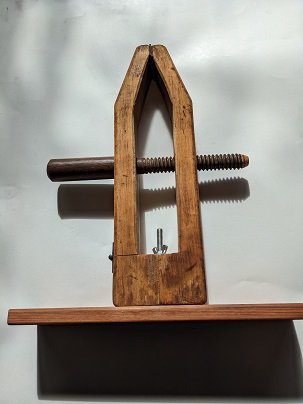
Laura showed the two inlaid name tags she made after admiring the one that Jamie wears to all the meetings.
She also showed off the leather stitching pony she made from an old hand screw clamp
Paul Krenitsky
